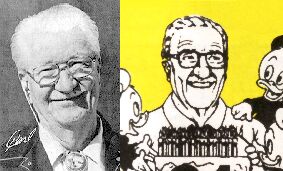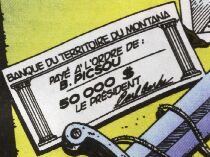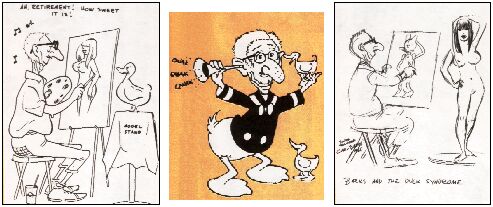- Disney Comics author, creator of Uncle Scrooge -
( 1901 - 2000 )

- Disney Comics author, creator of Uncle Scrooge -
( 1901 - 2000 )

| * List of the stories
and drawings
he appears in :
- W WDC 75-01 : "Turkey Trouble", from 1946, by himself (by name only); - W OS 199-02 : "Sheriff of Bullet Valley", from 1948, by himself ; - W WDC 188-01 : "The Olympic Hopeful", from 1956, by himself ; - W DG 26-01 : "The Christmas Cha Cha", from 1959, by himself ; - AR 106 : "Cash Flow", from 1987, by Don Rosa ; - AR 125 : "The Crocodile Collector", from 1988, by Don Rosa ; - AR 145 : "His Majesty, McDuck", from 1989, by Don Rosa (by name only) ; - D 90314 : "Return to Xanadu", from 1991, by Don Rosa (by name only) ; - D 92121 : "The New Laird of Castle McDuck" (Lo$#5), from 1992, by Don Rosa (by name only) ; - F PM 01201 C : "The Sharpie of the Culebra Cut" (Lo$#10b), from 2001, by Don Rosa (by name only) ; - FC PM 338D : "Les Inédits de Don Rosa #23" (an illustration for Barks' "Only a Poor Old Man"), from 2000, by Don Rosa. |
* His biography :
Carl Barks was
born on March 27, 1901, in a farm near Merrill, Oregon, where he grew up
and worked. Soon, he began having a passion for drawing.
In 1918, he moved to San Francisco
where he worked in a printing, and then had several odd jobs, while still
trying to have success in drawing. In 1928, he started being a humoristic
drawer, especially for The Calgary Eye-Opener.
In 1935, he sent his drawings to
the Disney Studios, who engaged him until 1942, when he decides to breed
chickens.
In 1943, his first Donald Duck story
was published, and was followed by a lot of other stories...
In December, 1947, he created Uncle
Scrooge McDuck, the Richest Duck in the World, in the story "Christmas
on Bear Mountain", soon followed by Gladstone Gander (1948), the Junior
Woodchucks (1950), the Beagle Boys (1951), Gyro Gearloose (1952), Flintheart
Golomgold (1956), Magica de Spell (1961), ... He is the man who
gave Donald Duck his personality.
He took everything in charge, in
his stories : plot, drawing, ink, and letters. He is the most famous drawer
of Donald, and also the most published.
In 1966, he retired, which didn't
keep him from writing plots for other drawers. In 1973, after getting Disney's
permission, he began painting more than 120 oil paintings with Disney
Ducks characters. In 1991, he became "A Disney Legend".
On August 25, 2000, he died from Leukemia.
* His place in the Barks/Rosa stories universe
:
First, in "Turkey Trouble", his name appears
on a dog soup can labeled "Barks Dog Soup".
In "Sheriff of Bullet Valley", Barks caricatured
himself on a wanted poster. In an interview by Michael Barrier from
May 30, 1971, Barks said: "That caricature originated in the old Disney
studio days in the gag sheets that us guys used to draw of each other and
circulate around. Some of the guys took to drawing me with this tremendous
big schnoz, so I just copied that old caricature."
In "The Olympic Hopeful", Barks caricatured
himself as Fulldrip Pulpbugle, a javelin hurler with hay fever.
In "The Christmas Cha Cha", Barks caricatured
himself on a wanted poster which tells "Wanted for being bad!
".
In "Cash Flow", Don Rosa re-used the wanted poster
from "Sheriff of Bullet Valley" with "Wanted for being Dad!
"
instead. It's in the Police office, just next another wanted poster with
Magica that tells "Wanted for witchcraft".
In Don Rosa's "The Crocodile Collector", a caricature
of Barks appears in a temple amongst hieroglyphics.
In "His Majesty, McDuck",
his name appears on Cornelius Coot's diary Scrooge is reading.
In "Return to Xanadu",
the mention "Barks was here" appears in a book in the library
in Tralla La.
In the splash panel of "The New Laird of Castle
McDuck", we can see the $ 10 000 check Marcus Daly
gave to Scrooge in the preceding episode of the Lo$. (For unknown reasons,
the French translator wrote 50 000$ instead of 10 000). This check is signed
by Carl Barks. This detail is unchanged from the original version
of Don Rosa's art, but is changed in only the American version since Gladstone
thought Barks would see it and not be amused for some reason.
On the last panel of "The Sharpie of the Culebra Cut",
we can see the dedication "C.B. 1901-2000 R.I.P." in the newspaper
article.
In the illustration "Les Inédits de Don Rosa
#23", Barks appears on a coin dated 1901.

Barks Gallery

Fulldrip Pulpbugle in "The Olympic Hopeful"
the diary
the book

the check

the article

Other caricatures of himself he made
>>>Back to the real life's characters page
>>> Back to the main page